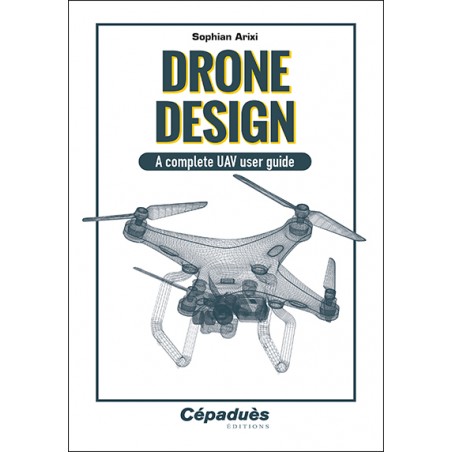





This book is the translation of the French 3rd edition of «Drones, Le guide des bonnes pratiques pour choisir, équiper et opérer»
Even for a professional, it’s not easy to choose from dozens of types of UAV that can perform various tasks. In order to choose for your particular needs, there are many questions that have to be addressed.

Commande avant 16h,
expédié le jour même (lu. - ve.)

Livraison express sous 48h.
This book is the translation of the French 3rd edition of «Drones, Le guide des bonnes pratiques pour choisir, équiper et opérer»
Even for a professional, it’s not easy to choose from dozens of types of UAV that can perform various tasks. In order to choose for your particular needs, there are many questions that have to be addressed.
For example :
• What are the different types of drones and their uses ?
• Is it better to build your drone yourself or buy a ready to fly model ?
• What are the elements of the drone that will enable you to make the right choice ?
• Which batteries to choose ?
• Which remote control to choose ?
A drone has to be seen as an aircraft carrying a payload. The need to align the task with the aircraft raises questions such as :
• How to design its payload ?
• If you are making it yourself, which 3D printer to use ?
• What are the impacts of the payload on the choice of the drone and the flight route ?
• How to choose components and the technology of the payload ?
Finally, operation also has its constraints :
• What precautions should be taken to operate in the field ?
• How should you organize your tasks ?
• How to set up the radio link to avoid a communication break ?
• Which launch and recovery systems to use ?
This book will help you answer these questions and ensure you get the most from your UAV.
| Référence : | 2137 |
| Nombre de pages : | 254 |
| Format : | 16x24 cm |
| Reliure : | Broché |
| Rôle | |
|---|---|
| Arixi Sophian | Auteur |
Acknowledgements
Warning
Chapter overview
Chapter 1 : An aircraft for a successful flight
1.1. Plane or copter ?
1.1.1. Take-off and landing place
1.1.2. Flight path trajectory
1.1.3. The payload
1.2. As a kit or ready-to-take-off ?
1.3. Innovations
1.3.1. Flexible wings
1.3.2. Imitating birds
1.3.3. « In the box » UAV
Chapter 2 : Specifying your UAV
2.1. Airplane specifications
2.1.1. The fuselage
2.1.2. Flying wings
2.1.3. The airfoil
2.1.4. When the airfoil becomes a wing
2.1.5. When wings are put on a plane
2.1.6. The landing gear
2.1.7. VTOLs (Vertical Take-Off and Landing)
2.1.8. Double tailed aircrafts
2.1.9. Bird-inspired aircrafts
2.1.10. Equations
2.1.11. Airspeed measure
2.2. Copters specifications
2.2.1. Frame choice
2.2.2. Engineization choice
Chapter 3 : Propulsion parts
3.1. Internal Combustion Engine
3.1.1. Power and consumption
3.1.2. Air-fuel ratio
3.2. Electric propulsion
3.2.1. ESCs (Electronic Speed Controllers)
3.2.2. Electrical power distribution board
3.3. Hydrogen propulsion
3.3.1. Physical properties
3.3.2. Hydrogen thermodynamic properties
3.3.3. Context
3.3.4. Storable modes
3.3.5. High pressure storage
3.3.6. Cryogenic storage
3.3.7. Motorizations
3.4. Propellers
3.4.1. Operation
3.4.2. Characteristics
3.5. Leveled flight
3.6. During climbing and descent
3.7. Endurance and range
3.8. Objectives
3.9. ICE and electric motor comparison
3.9.1. ICE
3.9.2. Electric motors
Chapter 4 : Specifying components
4.1. Autopilots
4.1.1. Hardware criteria
4.1.2. Firmware criteria
4.1.3. GCS criteria
4.1.4. Furthermore
4.1.5. Starting with Ardupilot
4.2. Inertial Navigation Systems
4.2.1. INS and IMU : definitions and working principles
4.2.2. Technologies
4.2.3. Configuration and integration
4.3. Cables and connectors
4.3.1. Signal connections
4.3.2. Power connections
4.4. GNSS (Global Navigation Satellite System)
4.4.1. Generalities
4.4.2. Improve your GNSS precision
4.4.3. The RTK (Real Time Kinematic) GNSS
4.4.4. The PPK GNSS
4.4.5. The GNSS PPP
4.5. Actuators
4.6. Batteries
Chapter 5 : The payload’s design
5.1. Conception
5.1.1. A method
5.1.2. Time management
5.1.3. On paper
5.2. Assembly
5.2.1. Choosing the developing board
5.2.2. Microcontrollers
5.2.3. Microprocessors
5.2.4. Comparison
5.2.5. FPGA and CPLD
5.3. Integration
5.3.1. Electrical supply and electronic communications
5.3.2. Electric cable distribution
5.3.3. Mechanical design notes
5.4. LIDAR (Laser Imaging Detection and Ranging)
5.4.1. Principle
5.4.2. The flightpath
5.4.3. Make your choice
5.4.4. Comparison with cameras (multispectral and photogrammetry)
5.4.5. Comparison with a RADAR
5.4.6. Comparison with ultrasonic sensors
5.5. Cameras (visible, thermal, multispectral and hyperspectral)
5.5.1. Photogrammetry
5.5.2. Generalities
5.5.3. Hyperspectral camera properties
5.5.4. Criteria
5.6. 3D printing
5.6.1. Doing your own 3D printing
5.6.2. Extrusion
5.6.3. Photopolymerization
5.6.4. Powder Bed Fusion
5.6.5. Material Jetting
5.6.6. Binder Jetting
5.6.7. Sheet lamination (SL)
5.6.8. Directed Energy Deposition
5.6.9. Conclusion on 3D printing processes
5.6.10. Materials
Chapter 6 : Operation
6.1. Meteorology
6.1.1. Definitions
6.1.2. The Wind
6.1.3. Turbulence
6.1.4. Cloud formation
6.1.5. Fog
6.2. Tools
6.3. Organization
6.3.1. Operation site visit
6.3.2. Maintenance
6.3.3. Preflight checking
6.3.4. Take-off systems
6.3.5. Landing systems
6.4. Safety systems
6.4.1. Returning home
6.4.2. The parachute
6.4.3. Self-destruction
6.4.4. The ADS-B/C system (Automatic Dependent Surveillance-Broadcast/Contract)
6.5. Radio link
6.5.1. The antenna and the link budget
6.5.2. Range calculation
Chapter 7 : A wide variety of civil users
7.1. Audiovisual
7.2. Building and Construction
7.3. Scientific research
7.4. Agriculture
7.5. Monitoring
Bibliography
Livres de l'auteur Sophian Arixi
Vous aimerez aussi